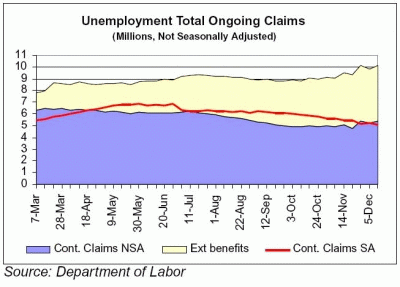Seasonal Adjustments Help To Report A Positive Employment Data
As I already wrote in multiple posts, I expect employment figures to post a positive surprise on Friday. Well, it seems that the Labor Department seasonal adjustments will provide large help to report positive data. New York Post Story: Why the government’s job figures won’t add up.
Since so few jobs were created in December 2008, the Labor Department’s computers were probably expecting the same pattern in this latest Christmas season, meaning that few jobs would be created in 2009 as well.
So even a small increase in jobs last month compared with December 2008 could be magnified in the accounting into something much bigger.
…
Friday’s figure will also be altered by job growth that the Labor Department is pretending has occurred at newly formed companies. The department calls this its birth/death model and by itself this assumption could be more destructive to the US economy than any terrorist attack could ever be.
For instance, in December 2008 the Labor Department assumed that 60,000 jobs were created by infant companies that couldn’t be surveyed, and weren’t contacted, by its workers. Without that assumption, the job losses that month would have been worse than the almost incomprehensible figure of 681,000 that was publicly announced.
The trouble is, those extra 60,000 jobs don’t exist.
In fact, the Labor Department has already said that when it reports its next set of statistics on Feb. 4 it will reduce the number of jobs that it believes existed in this country from April 2007 through March 2008 by around 820,000.
…
That 820,000 mistake only corrects the numbers as of last March. The birth/death model since this past April has added an additional 900,000 jobs. And eventually those 900,000 jobs will probably also have to be extracted from the Labor Department’s count.
…
In January 2009, a stunning 356,000 jobs were removed from the overall count because of the birth/death model. That resulted in a much larger-than-expected loss of jobs during the first month of the Obama administration. The panic was palpable.
Without a change, the Labor Department will subtract a similarly large number of jobs this January. And when that month’s labor figures are reported on Feb. 4, watch out! The stock market will not like this.
Zero Hedge summarizing a report by Michael Widner of Stifel, Nicolaus: A +316,000 NFP Print On Friday? The BLS Seasonal Fudge Factors Make It Very Likely.
In the simplest quantitative terms the Department of Labor’s seasonal adjustment model will assume 33% of this week’s initial claims are seasonal and will eliminate them from the as reported number. Next week it will jump to 45%.
…
This will likely result in initial claims reaching their highest level since last February next week while the model reports it as the lowest level in 18 months.
…
All in we believe there is a high likelihood that reported initial claims will fall below 400K next week (1/14) even if the jobs market doesn’t actually improve. This week is a bit less clear and we expect the reported number to actually come in fairly flat w/w and expect last week’s 434K number will likely be revised higher.
…
As we look to December data (reported this Friday) if this seasonal adjustment multiple returns to anything in the range of historical norms it should provide a huge lift to the reported m/m change. In quantitative terms a return to the 1996–2008 average would create a seasonal lift of 431K to the as-reported m/ m change. In comparison the 1996–2007 actual December m/m change (unadjusted) was 116K. Put differently, if this was an average December for job creation and the adjustment factor returns to a historical average we would see a non-farm payroll print of +316K on Friday.
…
We have no way of knowing what seasonal adjustment factor the BLS will use this month but we do know that eventually this imbalance will have to balance out. (Again, seasonal adjustments must work out to a zero sum across the year.) We suspect the BLS will smooth out that seasonal adjustment imbalance over the next several months, so we may get an upward bias of say 80K this month, 100K next month, then 120K, etc. Conspiracy theorists would suggest this might be an effective way to create the illusion of steady improvement that could potentially become self sustaining. (If we believe the economy could succumb to a placebo effect.) But it bears repeating, eventually these adjustments must all sum to zero.
Chart 1. Unemployment Total Ongoing Claims
I will be looking to re-initiate my long gold position, as it seems that the employment data will provide a picture of improving economic conditions and that could inflate a reflation trade.
